In most blogs or forums, macarons have been labeled to be one of the most difficult items to make in pastries. Though it has the simplest recipe in terms of ingredients, there are too many factors to be considered in making of a successful macaron.
Consecutively 7 attempts, we have come across errors and hiccups, making us change one parameter at a time. The recipe we followed is obtained from Syrup and Tang, involving the use of Italian meringue. And to all first timers, it is important to understand the basics of folding and whisking since the success of macarons depend greatly on the meringue and folding.
Ingredients needed:
Egg white (Please weigh, in this case let's assume to be 100gm)
1.35x Almond Flour Extra Fine (1.35 x 100 = 135gm)
1.35x Icing Sugar (1.35 x 100 = 135gm)
1.35x Caster Sugar (1.35 x 100 = 135gm)
0.297x Water (0.297 x 100 = 30gm)
3 egg whites would yield about 50 shells with a diameter of 40mm.
Steps
1. Mark grease proof paper with 40mm x 40mm squares, spaced 30mm apart
2. Sift icing sugar and almond flour separately
3. Use a spatula and mix the icing sugar and almond flour thoroughly
4. Beat the egg whites until soft peak
5. Fold in HALF the beaten egg whites into the icing sugar / almond flour mixture
6. Add colouring or flavourings during mixing
7. Place caster sugar and water in a saucepan, bring it to simmer over low heat
8. Beat the other HALF of the egg whites to firm peak
9. Set the beater to low speed and slowly pour the hot syrup into the beaten egg whites
10. As soon as all the syrup is in the egg whites, increase the beating speed to maximum until stiff peak
11. Fold in the icing sugar / almond flour mixture / egg whites paste in the meringue (in thirds)
12. Dab some batter under each corner of the baking paper to anchor it
13. Pipe the batter into small domes (i.e. keep nozzle vertical, dip nozzle in and make a small twist)
14. Give the baking pan a good whack on the counter
14. Leave the piped batter to dry for 30min to 1 hour
15. Preheat oven to 150°C
16. Bake the shells for 18 to 20min
17. Sufficiently-baked shells should be easy to peel off from the baking paper
Some things to note:

Note:
Most recipes would suggest processing the almond flour and icing sugar at high speed to achieve a fine mixture but often processors generate lots of heat, causing the almond powder to release oil
Therefore, we decided to sieve almond flour (extra fine) to get fine almond powder before mixing in the sieved icing sugar
Possible Error:
Using a spoon to speed up the process of sifting almond flour will lead to clogging of the sieve due to the released oil. Patience is the trick
I have tried sieving icing sugar and almond flour together but I often get almond flour stuck at the sieve with the icing sugar sieved into the bowl. In the end, we found it more convenient to sieve them separately.

Note:
Most recipes also emphasize on the importance of aging egg whites, since we are always making macarons in an impromptu manner, we left the egg whites in the warm oven (37-40°C) to evaporate the water (i.e. we warm up the oven 4x over a span of 5-6 hours)
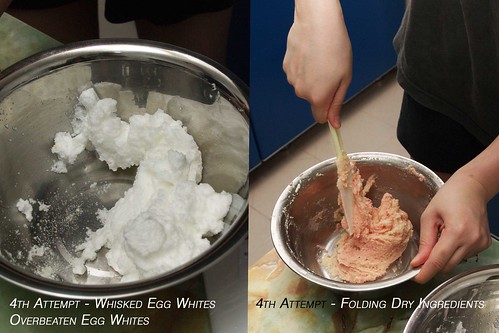
Note:
I made a mistake in interpreting Duncan's recipe. The recipe states mixing half the unbeaten egg whites into the dry ingredients, in my 1st to 6th attempts, I used beaten egg whites (soft peak) instead of the unbeaten ones.
The main difference is beaten egg whites (soft peaks) seems to allow the macaron shells to rise higher with more distinctive feet while overbeaten egg whites or unbeaten egg whites appears to generate thinner shells.
Possible Error:
Improper folding may lead to a watery batter
Meringue powder are NOT advisable to replace egg whites, upon mixing in the dry ingredients, the batter collapse into a liquid state
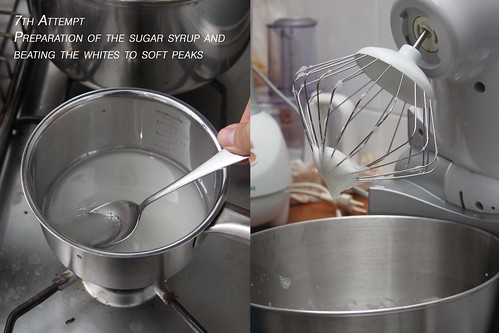
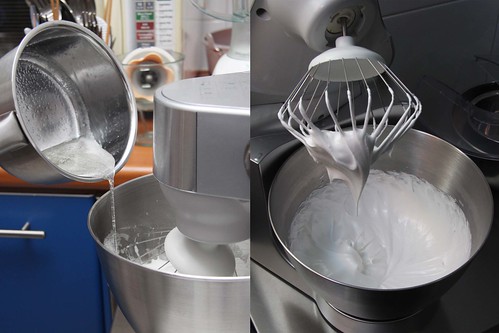
Note:
For preparation of the sugar syrup (to be added to the beaten egg whites), we reduced the amount of water by 10% (we use 0.297x instead of 0.33x).
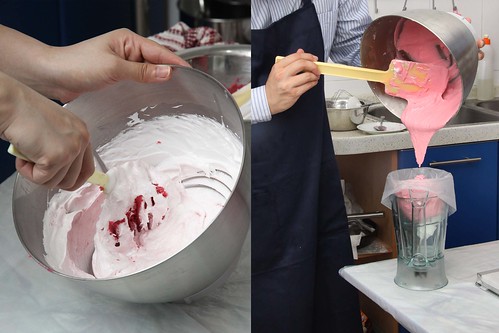
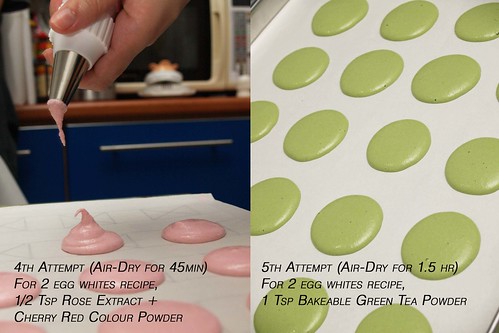
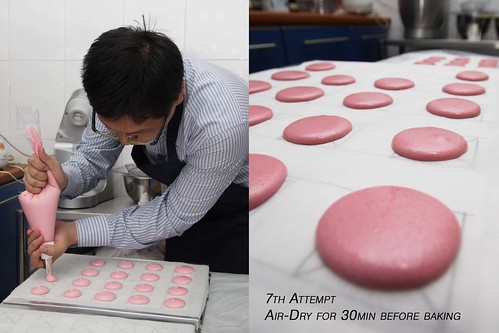
Note:
Use good baking paper such as Glad Bake (Non-stick baking and cooking paper. When the wrong baking paper is used, you will get the formation of Mt. Fuji instead of a proper macaron.

Note:
The purpose of drying is to form a skin, this will facilitate the formation of a good macaron "cap".
Baking temperature is important. I kept my baking time fixed at 15min while trying to find an optimum temperature.
130°C to 140°C - Shells are undercooked, wet core with soft and flimsy crust
150°C to 160°C - Crisp crust with meaty core (Optimum temperature for my home oven)
170°C - Shells are overcooked and burnt on its crust, chewy core
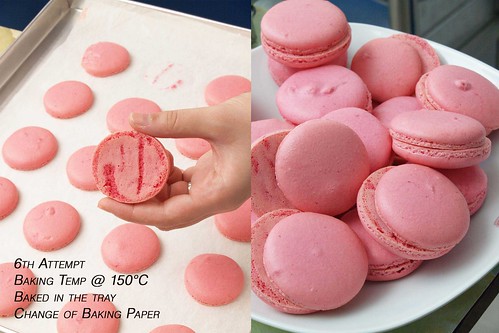
Note:
Macaron shells should be easy to peel off. If you experience sticky macarons with their bellies behind, you can try to bake it awhile longer.
Alternatively (as suggested by Duncan and Tartelette), you can try to moisten the underside of the baking paper to facilitate the peeling of the shells.
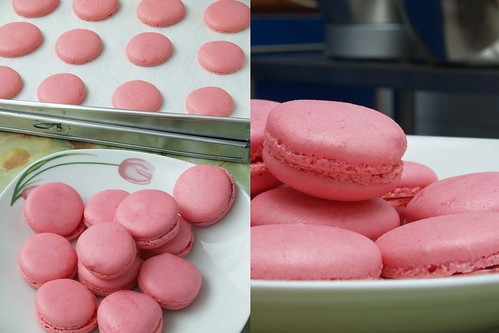
With a shorter baking time (i.e. 16min @ 150°C), the wet bellies get stuck onto the baking paper, making it hard to peel; but the shells are meatier and moist, thereby contrast well with the crisp shells
With a slightly longer baking time (i.e. 20min @ 150°C), the macarons are much easier to peel off and are chewier. I prefer my shells to be softer so I kept my baking time at about 17-18min, upon refrigeration, the shells are still chewy to my liking.
I haven't been adventurous with the flavours and for convenience, I used rose extract and cherry red colour extract, surprisingly the rose fragrance is very distinctive and compliments pretty well with the unflavoured buttercream. I tried using bakeable green tea powder and the taste turns out to be decent. Between the two, most of my guinea pigs prefer the rose flavoured ones.
Despite the amount of sugar and icing sugar used, sweetness is acceptable and is neutralized when filled with (salted) buttercream. All in all, the macarons have no air pockets and we are satisfied with the results. Happy to get it right after a few days of troubleshooting.
And to all my dear readers, I am now left with tonnes of egg yolks, any easy recipes to recommend or share?
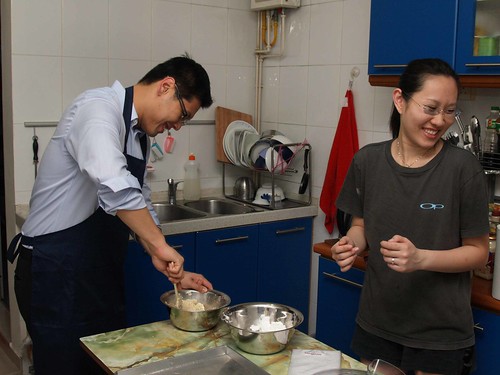

14 comments:
i've tried twice and i still haven't succeeded xD But at least my second try was an improvement!
Use your yolks to make custard for tarts :D
wow i gotta admire your patience!
try making creme brulee! but if you don't have a blowtorch, try hollandaise sauce or chocolate mousse. or custard-based ice-cream or carbonara!
fen, trust that you're well now.
Tiramisu & ice creams. (:
Oysterdiaries: Do you use the French meringue or the Italian meringue recipe? I have yet to try the French one since this is pretty consistent on my first 2 attempts. Just out of curiousity, how did your shells turn out in both attempts?
Stargirl: Actually it is quite fun making it. I kinda got the feet at the right place while making it the second time, but my 3rd to 5th attempts became "Mt. Fuji" or poorly formed shells and the main difference was that I changed the baking paper. I told myself to try it one more time (6th attempt) with a change of baking paper and if it fails, I am going to discard the recipe. Miraculously, the shells turned out to be good.
Ice: Not really, tore my wound again T.Tlll. I was very careful with my diet, not even eating complete meals, just enough to make myself full and the same thing happens again... I am back on my laxatives :"(
Thanks everybody for the suggestions... Time to hunt for new recipes...
Strangely, no one suggested kueh lapis???
definitely ice cream for the hot weather!
great looking shells you have there by the way!
Looks like it is time to invest in an ice-cream machine.
Thank you for the compliment =)
Make Breton Cake with your egg yolks. This cake is addictive!
Ingredients
•1¼ cups sugar
•scrapings from the inside of a vanilla bean
•½ cup hazelnuts, lightly toasted, husked
•6 large egg yolks
•1 cup salted butter, melted
•2 cups unbleached all purpose flour
•1 large egg yolk beaten with 2 teaspoons water (for glaze)
•Whole strawberries or raspberries
How to make it
•Make certain the hazelnuts have been toasted and husked. Husking involves simply roasting the nuts on a sheet pan at about 350°F for 10 minutes or so, then putting them in a towel and rubbing them together until they have shed their skins.
•Position rack in center of oven and preheat to 325°F.
•Butter and flour a 9-inch-diameter springform pan. Combine 2 tablespoons sugar, half of the vanilla bean scrapings, and hazelnuts in a food processor; blend until nuts are finely ground but not pasty. You're not making marzipan, so don't overdue the grinding.
•Combine 6 egg yolks and remaining 1 cup plus 2 tablespoons sugar and the rest of the vanilla bean scrapings in large bowl; whisk until well blended and slightly thicker, about 2 minutes (I would strongly advise NOT using an electric mixer). Whisk in hazelnut mixture. Gradually whisk in melted butter.
•Sift flour over batter; stir just until blended (batter will be thick; do NOT overmix or the flour will develop glutens and the cake will end up chewy and tough).
•Transfer batter to prepared pan; smooth top with an offset spatula. Brush top generously with egg glaze. Using the tines of a fork, deeply mark a crisscross pattern on the cake, marking 3 times across in 1 direction and 3 times in the opposite direction.
•Bake the cake until it's a deep golden on top and a tester inserted into the center comes out clean, about 1 hour.
•Cool in pan on rack 15 minutes, then remove pan sides and cool cake completely.
•You can make this cake one day ahead of time; wrap it in foil and store at room temperature.
•To serve, cut the cake into wedges and serve with some creme fraiche or whipped cream and whole berries.
Make some ice cream and tell us your experience with it!
Thank you for the recipe. Just a question, I notice there is no milk nor oil in the cake, is the cake meant to be dry?
Geez, looks like I need an ice-cream maker soon...
Hi Anonymous,
Based on your recipe, is the Breton Cake suppose to be firm & dry or sticky like gum?
To Fen,
I checked other Breton recipes, it is true that there is no water or milk
added..
the Breton cake is meant to be a bit dry, sort of like shortbread. The butter and egg yolks provide sufficient moisture and holds the mixture together.
will you be making more macarons and selling them?
Hmm... That might be the cake that my dad likes. Thanks for the recipe.
I won't be making more macarons to sell them but I might attempt to make some to test my new oven.
Apart from that, I doubt I will make them often, given the amount of sugar and calories. In fact, I would prefer to pick up one or two from my favourite macarons haunt.
how should we keep the macarons? should we keep it once it cold?
I usually keep it in the chiller...
Post a Comment